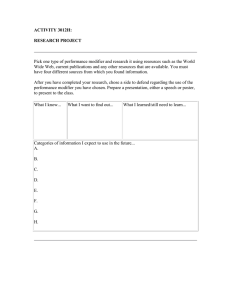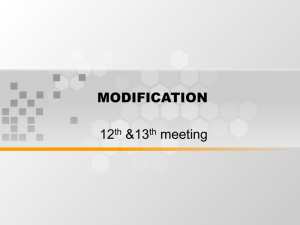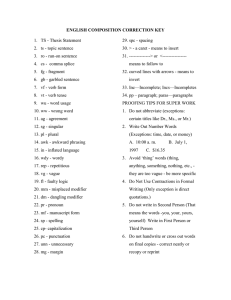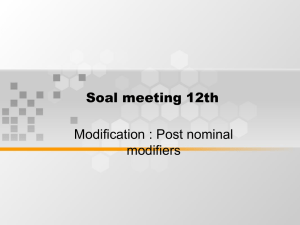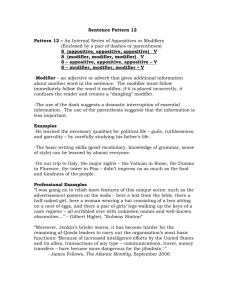Modifier -25 – Significant, Separately Identifiable E/M
advertisement
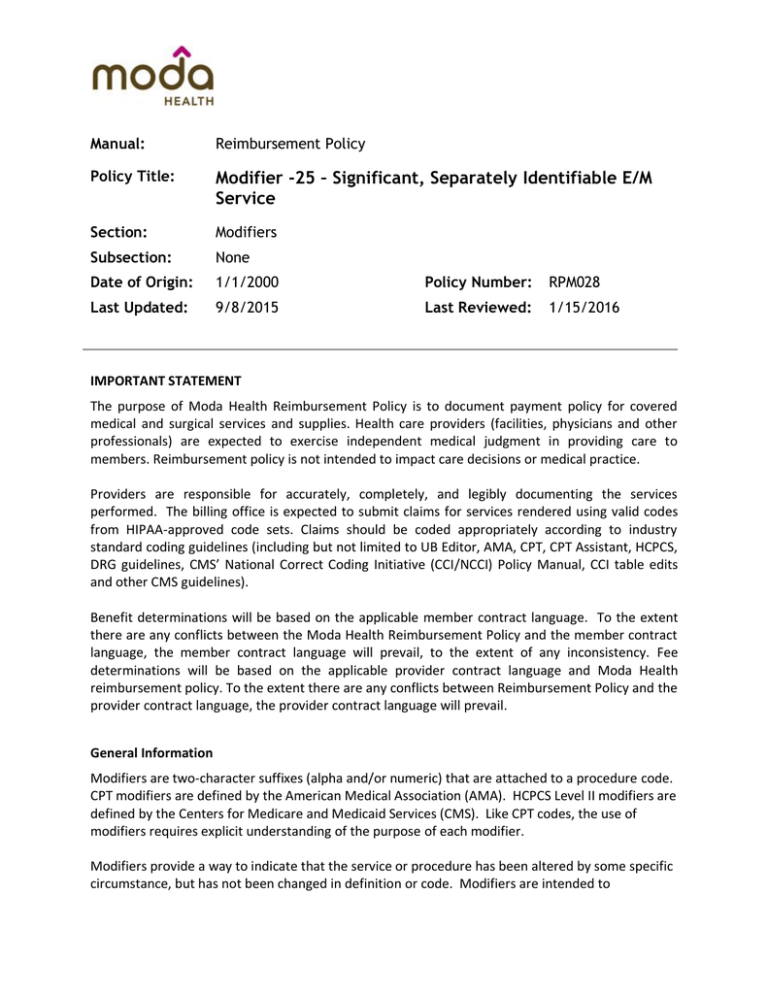
Manual: Reimbursement Policy Policy Title: Modifier -25 – Significant, Separately Identifiable E/M Service Section: Modifiers Subsection: None Date of Origin: 1/1/2000 Policy Number: RPM028 Last Updated: 9/8/2015 Last Reviewed: 1/15/2016 IMPORTANT STATEMENT The purpose of Moda Health Reimbursement Policy is to document payment policy for covered medical and surgical services and supplies. Health care providers (facilities, physicians and other professionals) are expected to exercise independent medical judgment in providing care to members. Reimbursement policy is not intended to impact care decisions or medical practice. Providers are responsible for accurately, completely, and legibly documenting the services performed. The billing office is expected to submit claims for services rendered using valid codes from HIPAA-approved code sets. Claims should be coded appropriately according to industry standard coding guidelines (including but not limited to UB Editor, AMA, CPT, CPT Assistant, HCPCS, DRG guidelines, CMS’ National Correct Coding Initiative (CCI/NCCI) Policy Manual, CCI table edits and other CMS guidelines). Benefit determinations will be based on the applicable member contract language. To the extent there are any conflicts between the Moda Health Reimbursement Policy and the member contract language, the member contract language will prevail, to the extent of any inconsistency. Fee determinations will be based on the applicable provider contract language and Moda Health reimbursement policy. To the extent there are any conflicts between Reimbursement Policy and the provider contract language, the provider contract language will prevail. General Information Modifiers are two-character suffixes (alpha and/or numeric) that are attached to a procedure code. CPT modifiers are defined by the American Medical Association (AMA). HCPCS Level II modifiers are defined by the Centers for Medicare and Medicaid Services (CMS). Like CPT codes, the use of modifiers requires explicit understanding of the purpose of each modifier. Modifiers provide a way to indicate that the service or procedure has been altered by some specific circumstance, but has not been changed in definition or code. Modifiers are intended to communicate specific information about a certain service or procedure that is not already contained in the code definition itself. Some examples are: To differentiate between the surgeon, assistant surgeon, and facility fee claims for the same surgery To indicate that a procedure was performed bilaterally To report multiple procedures performed at the same session by the same provider To report only the professional component or only the technical component of a procedure or service To designate the specific part of the body that the procedure is performed on (e.g. T3 = Left foot, fourth digit) To indicate special ambulance circumstances More than one modifier can be attached to a procedure code when applicable. Not all modifiers can be used with all procedure codes. Modifiers do not ensure reimbursement. Some modifiers increase or decrease reimbursement; others are only informational. Modifiers are not intended to be used to report services that are "similar" or "closely related" to a procedure code. If there is no code or combination of codes or modifier(s) to accurately report the service that was performed, provide written documentation and use the unlisted code closest to the section which resembles the type of service provided to report the service. Codes and Definitions E/M E&M E&M Evaluation and Management (Abbreviated as “E/M” in CPT book guidelines, sometimes also abbreviated as “E&M” or “E & M” in some CPT Assistant articles and by other sources.) Modifier 25 Significant, Separately Identifiable Evaluation and Management Service by the Same Physician or Other Qualified Health Care Professional on the Same Day of the Procedure or Other Service: It may be necessary to indicate that on the day a procedure or service identified by a CPT code was performed, the patient’s condition required a significant, separately identifiable E/M service above and beyond the other service provided or beyond the usual preoperative and postoperative care associated with the procedure that was performed. A significant, separately identifiable E/M service is defined or substantiated by documentation that satisfies the relevant criteria for the respective E/M service to be reported (see Evaluation and Management Services Guidelines for instructions on determining the level of E/M service.) The E/M service may be prompted by the symptoms or condition for which the procedure and/or service was provided. As such, different diagnoses are not required for reporting of the E/M services on the same day. The circumstances may be reported by adding modifier 25 to the Page 2 of 8 appropriate level of E/M service. Note: This modifier is not used to report an E/M service that resulted in a decision to perform surgery. See modifier 57. For significant, separately identifiable nonE/M services, see modifier 59. Reimbursement Guidelines Modifier 25 is considered valid on Evaluation and Management (E/M) procedure codes only (based on modifier definition). Modifier 25 is not considered valid when appended to surgical codes, medicine procedures, diagnostic tests and procedures, etc. and the line item will be denied as an invalid modifier combination. (RPM019B) E/M service codes submitted with modifier 25 appended will be considered separately reimbursable when all of the following apply: The clinical edit is eligible for a modifier bypass (e.g. per edit rationale, CCI modifier indicator = “1”, etc.). The modifier and the code have been submitted in accordance with AMA CPT book guidelines, CPT Assistant guidelines, CMS/NCCI Policy Manual guidelines, and any applicable specialty society guidelines. The procedure code is eligible for separate reimbursement according to the status indicators on the CMS fee schedule for the relevant provider type (physician fee schedule, ASC, OPPS, etc). The medical records documentation supports the appropriate use of modifier 25. All of the required key components of the E/M service with modifier 25 appended must be documented in the medical record. The submission of modifier -25 appended to a procedure code indicates that documentation is available in the patient’s records which will support the distinct, significant, separately identifiable nature of the evaluation and management service submitted with modifier -25, and that these records will be provided in a timely manner for review upon request. All surgical procedures and some non-surgical procedural services include a certain degree of physician involvement or supervision, pre-service work, and post-service work which is integral to that service. For those procedures and services a separate E/M service is not normally reimbursed. However, a separate E/M service may be considered for reimbursement if the patient’s condition required services above and beyond the usual care associated with the procedure or service provided and modifier -25 is appended to the E/M code. None of the usual pre-service, intraservice, or post-service work associated with the other procedure(s) performed on the same day may be included in the documentation to support the key components of the significant, separately identifiable E/M service. CPT guidelines for specific code categories highlight certain services where special attention should be given to the concept of an E/M integral to the procedure. The National Correct Coding Initiative Page 3 of 8 Policy Manual, chapter one, also addresses that minor surgical procedures include the decision for surgery E/M service; E/M of a second, unrelated problem would be eligible for consideration of modifier 25. The documentation of the procedure and the documentation of the significant, separately identifiable E/M service must be clearly separate and distinct in the medical record in order to fulfill the requirements of “separately identifiable.” If both services are mixed together in a single visit entry without any separation (e.g. under a sub-heading) to identify the separate and distinct nature of the services, then the requirement for a “separately identifiable” service has not been met. Multiple E/M Services Only one E&M service code per patient, per physician, per day is eligible for reimbursement, with the following exceptions: Two separate visits occurred at different times of day and for unrelated problems that could not be anticipated or addressed during the same encounter. o For example, a scheduled office visit occurs in the morning for upper respiratory infection and 4 hours later an unscheduled visit for a fall with injured knee. o Modifier 25 would be appended to the second visit. Additional information regarding the two separate times should be supplied in box 19 of the claim form, or the equivalent field in the electronic claims submission process. o Note: If the patient mentions the second problem at the first visit, and the provider asks the patient to return later in the day for the assessment of the second problem, then all evaluation and management services provided that day would be included in the selection of a single E/M service code. Preventive Medicine Service with Problem-oriented E/M Service When, in the process of performing a preventative medicine examination, a preexisting problem is addressed or an abnormality is encountered and the problem/abnormality is significant enough to require the additional work of the key components of a problem-oriented E&M service, the problem-oriented outpatient established patient E/M service code with modifier 25 appended is eligible for separate reimbursement in addition to the preventive visit service. Page 4 of 8 Appropriate Use of Modifier 25 # Example Scenario 1 An established patient is seen for periodic follow-up for hypertension and diabetes. During the visit, the patient asked the physician to address right knee pain which developed after recent yard work. The physician performed a problem-focused history and exam of the patient’s hypertension and diabetes, and adjusted medications. Then the physician evaluated the knee and performs an arthrocentesis. An established patient is seen for a 2.0 12001 finger laceration, which is closed with a 99213-25 simple repair. The patient also asks the physician to evaluate sinus problems, which is addressed with an expanded problem-focused history and exam and low medical decision making. 2 Correct Code(s) 99212-25 20610 Coding Rationale Correct Code(s) 20610 Coding Rationale The evaluation of the knee problem is included in the arthrocentesis reimbursement. The presenting problem for the visit was other than the knee problem. A separate evaluation of the hypertension and diabetes was performed (Grider4) (and would have been performed if the knee problem did not exist), making the use of modifier 25 appropriate. The patient presented to the provider with two problems. A surgical procedure was performed, and a separate E/M service was performed to address the second problem. The visit notes clearly document the assessment and treatment of the two problems separately. (Grider4) Improper Use of Modifier 25 # Example Scenario 3 An established patient returns to the orthopedic physician with escalating right knee pain 6 months post a series of Hyaluronan injections. After evaluating the knee and the patient’s medical suitability for the procedure (meds, vitals, etc.), the physician determines a second series of hyaluronan injections is needed and performs the first of three intraarticular injections. Page 5 of 8 It would not be appropriate to bill the E/M visit, because the focus of the visit is related to the knee pain, which precipitated the injection procedure. The evaluation of the knee problem and the patient’s medical suitability for the procedure is included in the injection procedure reimbursement # Example Scenario 4 A 63-year-old woman presents with complaint of multiple skin lesions in the neck and axilla areas which itch and get painfully caught in clothing and jewelry. Removal was recommended and informed consent was obtained. A total of 23 lesions were removed. Correct Code(s) 11200 11201 Coding Rationale The office visit is considered part of the surgery service and therefore not separately reimbursable. The use of modifier 25 is not appropriate because the E/M service did not go above and beyond the usual preoperative service. (Grider4) Also, since 11200 has a global period of 010 days, the decision for surgery E/M services on the same date of service as the minor surgical procedure are not eligible to be reported with modifier 57 either, but are included in the payment for the surgery procedure. (CMS2) Coding Guidelines “Modifiers may be appended to HCPCS/CPT codes only if the clinical circumstances justify the use of the modifier. A modifier should not be appended to a HCPCS/CPT code solely to bypass an NCCI edit if the clinical circumstances do not justify its use. If the Medicare program imposes restrictions on the use of a modifier, the modifier may only be used to bypass an NCCI edit if the Medicare restrictions are fulfilled.” (CMS2) “Modifier 59 and other NCCI-associated modifiers should NOT be used to bypass an NCCI edit unless the proper criteria for use of the modifier are met. Documentation in the medical record must satisfy the criteria required by any NCCI-associated modifier used.” (CMS2) “Modifier 25 may be appended to E&M services reported with minor surgical procedures (global period of 000 or 010 days) or procedures not covered by global surgery rules (global indicator of XXX). Since minor surgical procedures and XXX procedures include pre-procedure, intra-procedure, and post-procedure work inherent in the procedure, the provider should not report an E&M service for this work. Furthermore, Medicare Global Surgery rules prevent the reporting of a separate E&M service for the work associated with the decision to perform a minor surgical procedure whether the patient is a new or established patient.” (CMS2) “The CPT codes for procedures do include the evaluation services necessary prior to the performance of the procedure (eg, assessing the site/condition of the problem area, explaining the procedure, obtaining informed consent), however, when significant and identifiable (ie, key components/counseling) E/M services are performed, these services are not included in the Page 6 of 8 descriptor for the procedure or service performed. It is important to note that the diagnosis reported with both the procedure/service and E/M service need not be different, if the same diagnosis accurately describes the reasons for the encounter and the procedure.” (AMA3) “Osteopathic manipulative treatment (OMT) is a form of manual treatment applied by a physician or other qualified health care professional to eliminate or alleviate somatic dysfunction and related disorders. This treatment may be accomplished by a variety of techniques. Evaluation and management services including new or established patient office or other outpatient services (99201- 99215)… may be reported separately using modifier 25 if the patient’s condition requires a significant, separately identifiable E/M service above and beyond the usual preservice and postservice work associated with the procedure.” (AMA6) “The chiropractic manipulative treatment codes [98940 – 98943] include a pre-manipulation patient assessment. Additional evaluation and management services including office or other outpatient services (99201 – 99215)…may be reported separately using modifier 25 if the patient’s condition requires a significant, separately identifiable E/M service above and beyond the usual preservice and postservice work associated with the procedure.” (AMA6) “When the patient is admitted to the hospital as an inpatient in the course of an encounter in another site of service (eg, hospital emergency department, observation status in the hospital, office, nursing facility) all evaluation and management services provided by that physician in conjunction with that admission are considered part of the initial hospital care when performed on the same date as the admission. The inpatient care level of service reported by the admitting physician should include the services related to the admission he/she provided in the other sites of service as well as in the inpatient setting. Evaluation and management services including new or established patient office or other outpatient services (99201-99215), emergency department services (99281-99285), nursing facility services (99304-99318), domiciliary, rest home, or custodial care services (99324-99337), home services (99341-99350), and preventive medicine services (99381-99397) on the same date related to the admission to “observation status” should not be reported separately.” (AMA7) “An E&M service is separately reportable on the same date of service as a procedure with a global period of 000, 010, or 090 under limited circumstances…If an E&M is performed on the same date of service as a major surgical procedure for the purpose of deciding whether to perform this surgical procedure, the E&M service is separately reportable with modifier 57. Other preoperative E&M services on the same date of service as a major surgical procedure are included in the global payment for the procedure and are not separately reportable. If a procedure has a global period of 000 or 010 days, it is defined as a minor surgical procedure. In general E&M services on the same date of service as the minor surgical procedure are included in the payment for the procedure. The decision to perform a minor surgical procedure is included in the payment for the minor surgical procedure and should not be reported separately as an E&M service. However, a significant and separately identifiable E&M service unrelated to the decision to Page 7 of 8 perform the minor surgical procedure is separately reportable with modifier 25. The E&M service and minor surgical procedure do not require different diagnoses. If a minor surgical procedure is performed on a new patient, the same rules for reporting E&M services apply. The fact that the patient is “new” to the provider is not sufficient alone to justify reporting an E&M service on the same date of service as a minor surgical procedure.” (CMS8) Cross References A. “Clinical Editing.” Moda Health Reimbursement Policy Manual, RPM002. B. “Valid Modifier to Procedure Code Combinations.” Moda Health Reimbursement Policy Manual, RPM019. References & Resources 1. American Medical Association. “Appendix A – Modifiers.” Current Procedural Terminology (CPT). Chicago: AMA Press. 2. CMS. National Correct Coding Initiative Policy Manual. Chapter 1 General Correct Coding Policies, § E, “Modifiers and Modifier Indicators.” 3. American Medical Association. "Appropriate Use of Modifier -25." CPT Assistant, September 1998: 4. 4. Grider, Deborah J. Coding with Modifiers: A Guide to Correct CPT and HCPCS Level II Modifier Usage. Chicago: AMA Press, 2004, pp. 59-71. 5. American Medical Association. “Modifiers, 25 (Q&A)”. CPT Assistant. Chicago: AMA Press, January 2008, p. 9. 6. American Medical Association. “Osteopathic Manipulative Treatment guidelines and Chiropractic Manipulative Treatment guidelines.” Current Procedural Terminology (CPT). Chicago: AMA Press. 7. American Medical Association. “Initial Hospital Care.” Current Procedural Terminology (CPT). Chicago: AMA Press. 8. CMS. National Correct Coding Initiative Policy Manual. Chapter 1 General Correct Coding Policies, § D, “Evaluation and Management (E&M) Services.” Page 8 of 8
